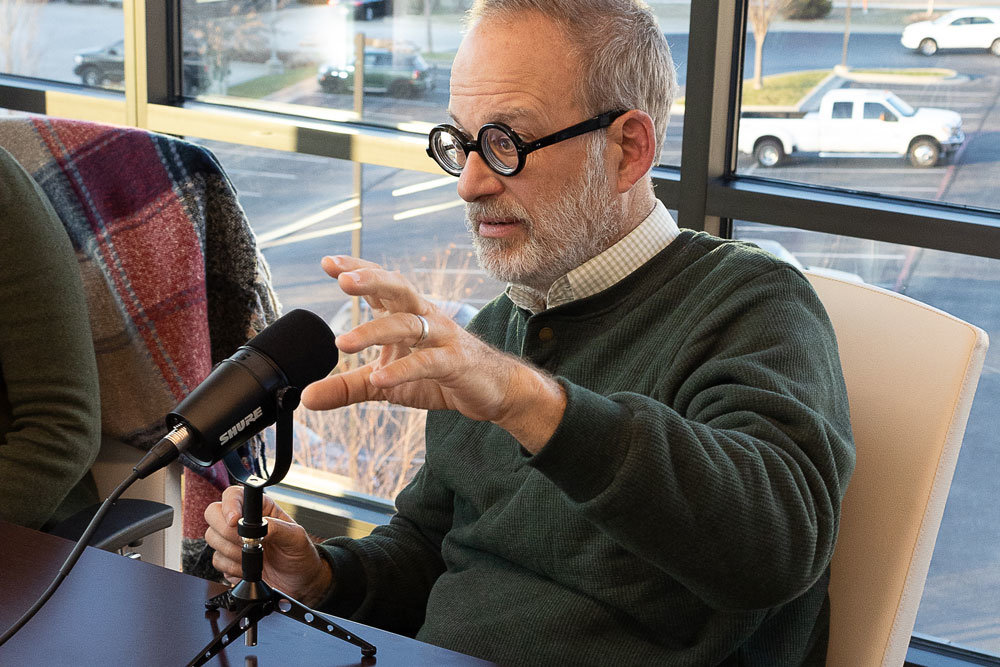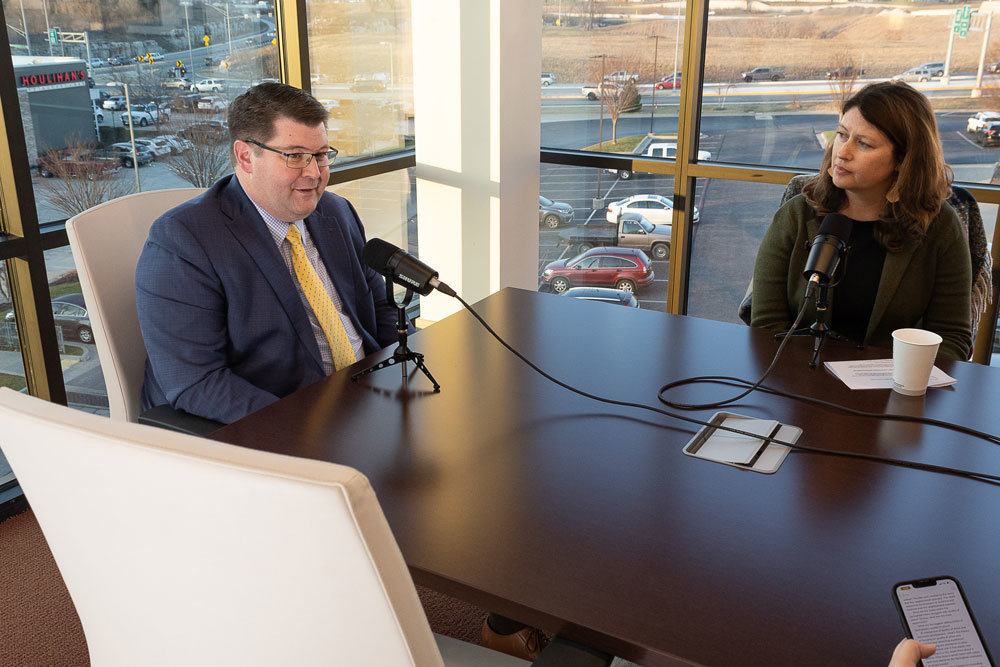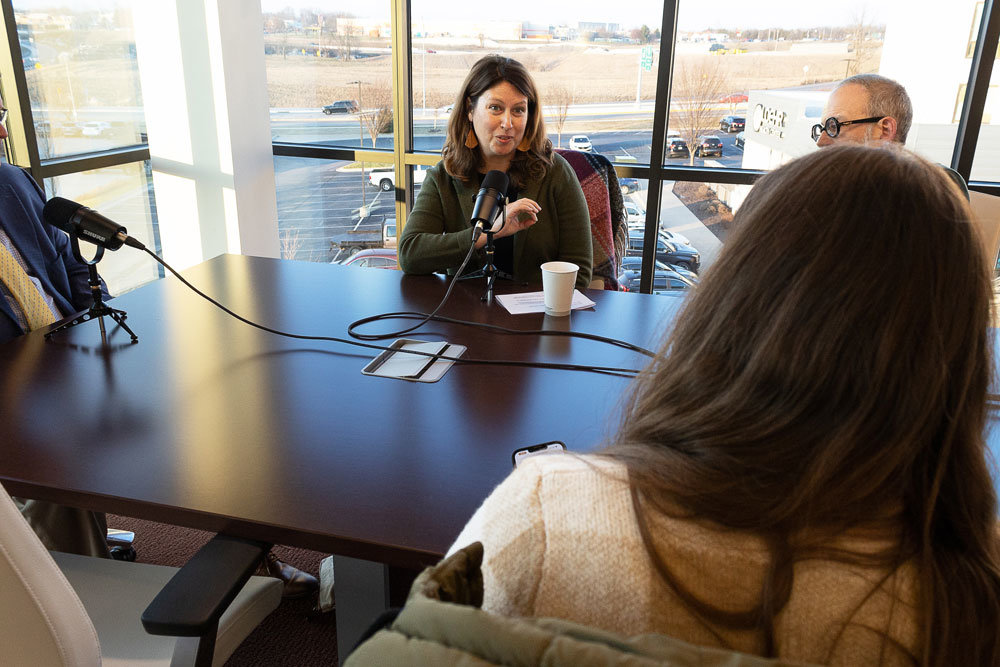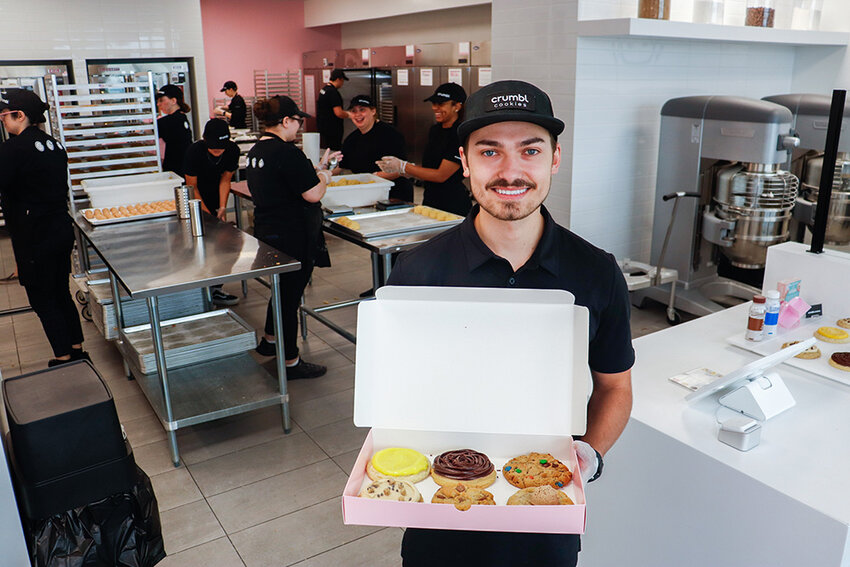YOUR BUSINESS AUTHORITY
Springfield, MO
YOUR BUSINESS AUTHORITY
Springfield, MO






Editor’s note: In 2023, SBJ’s CEO Roundtable feature will be released as a podcast. Check them out at SBJ.net/SBJPodcasts.
Springfield Business Journal Executive Editor Christine Temple discusses the concept of quality of place with Mary Kromrey, director of Ozark Greenways Inc.; Matt Morrow, president of the Springfield Area Chamber of Commerce; and Tim Rosenbury, director of quality of place initiatives for the city of Springfield.
Christine Temple: Let’s start with the definition of quality of place.
Tim Rosenbury: I’ve been thinking about that for the last almost three years. When we talk about quality of place, we’re talking about those intangibles of a true physical place, a location, a local neighborhood, a community, a corridor, that you say, “That’s a really interesting place.” It has something to do with attraction of memory; it ignites your passion, your curiosity. I think that’s really the definition of place. Now when we talk about quality of place, we’re talking about places that do that well.
Mary Kromrey: How do you quantify that secret sauce? Why places feel so special, why you want to go back, why you want to linger, why you want to meet with your friends and family there? I think it’s really a coalescence of many things, whether it is civic attractions or culturally aware things that you do, right? Events like Park Day at Silver Springs Park. To me, that is just a great example of quality of place, the built environment, all of these things coming together where people just want to be. You can’t put your finger on it, though.
Matt Morrow: There are some communities and regions that just do this exceptionally well. The ones that do it best are the ones that do it most intentionally. Place happens one way or another, and some of it’s memorable. Some of it’s less memorable.
Rosenbury: Stay away from that place. I don’t want you going near that place.
Morrow: Of course, from a business perspective, it’s a talent play. People increasingly can live anywhere they want to and work from there. So, you want to be a place where people want to work, want to live, so that they can work from there and invest in that community and grow there.
Temple: The quality of place that you guys are describing might be different for me than it is for you. As a city, though, we’re trying to create this unified vision. But we’ve seen in this last year what that looks like when definitions are at odds. One example that I’m thinking of is the bike park that students created out of a wooded area in a Springfield residential neighborhood. It was kind of done in secret, then the city came on board, then Greenways came on board, but then the neighborhood opposed it. We also have a development that’s going across a busy intersection at Sunshine Street and National Avenue where we’re trying to add commercial options, but the neighborhood opposes that. Quality of place is at odds. How do we come together when the definitions are different?
Rosenbury: A lot of what you’re talking about is change. The problem is that change is going to happen in Springfield whether we want it to happen or not. I heard a wise person say some time ago that change that we create can be exhilarating, but change that we ignore and is imposed on us is debilitating. The challenge for all of us, particularly those of us who are agents of change, is how we engage the community. What we have to do is frame these proposed changes in a way that seem to make sense. Then those of us who are the initiators of change need to be sincere in our effort. This is what can cause real problems in a community like ours, particularly now that much of it is already built out. It’s not like we’re going to take that open field and build something there. Now we’re going to change that thing that I’ve seen out my backyard for the past 30 years, and it’s going to be something different. This is not easy, but it is inevitable. Otherwise, we die as a community.
Morrow: If you can eliminate the possibility, as much as sometimes people might want this, that things will stay exactly as they are now forever – that’s just the one thing that we can guarantee will never happen. But, on the other hand, change is sometimes frightening to people. When we’re afraid, we don’t always think about the right things. I just think a big part of it is really embracing progress. I heard a wise person one time say that you can progress or you can regress, but there’s no “ress.” The movement is either going to be toward something positive or it’s going to be going in the direction that none of us want and decline.
Kromrey: Quality of life does mean different things to different folks. We have a large percentage of our population that are of a certain generation where quality of place may mean very manicured lawns, excellent police and fire, zero potholes. Things are very routine, traffic flows smoothly. Whereas another segment of our population, based on their generation, may value quality of place as wonderful outdoor amenities, whether it’s easy access to float on the James River, or easy access to leave their home to hop on a trail or any of our other beautiful natural environments that we have – recognizing that there’s some inherent friction there, but also realizing we all do ultimately want what’s best for our community. Even with the last census, we realize that for folks 24 and younger, we are literally losing population in that area. As we work to attract our future workforce and our future voters, … our future parents, employees, we’re going to want to do things that attract them here but might not be top priority for the folks that already live here or are a part of another generation. How do we coalesce those things?
Morrow: That’s one of the things about the quality of place, isn’t it? A diverse community should have a diverse place, too. My kids aren’t going to want the same thing that I want. And if you have to break the tie, I hope you’ll break it in their favor. You have more years of them than you have of me.
Rosenbury: In just a few days, I’ll turn 66, and I’m responsible in many ways for the future form of this community, but I’m not basing it on my preferences. I think of my granddaughters, third- and fourth-graders Rachel and Mary, and I’m not even sure that I always think about them. I think about their kids. Building a city happens over generations. It happens bit by bit, but hopefully you see the city coalesce into something over time. This isn’t going to happen overnight.
At odds
Temple: In this last election, 71% of voters said no change in Galloway. We don’t want this new development that was going to be a multiuse space across from Sequiota Park. Practically speaking, how do you get to the same table?
Morrow: That’s the first time the voters have chosen on the zoning case in any of our lifetimes, I believe, even though the provision has existed for it for 70 years. Planning and zoning cases are inherently complex and highly technical. That’s why you have highly professional, well-trained staff that review and evaluate. That’s why you have a number of volunteer leaders in the community who serve on planning and zoning and spend hours really reviewing that and asking questions and evaluating how that property should work. It’s why we have elected officials who, on behalf of the community, have to evaluate that as well and take into consideration everybody’s view. I would contend that a zoning case that goes on a ballot will lose every time. These are complicated issues that were never designed to be decided on the ballot. The bigger question I think that you’re getting at is, well, what does that mean? What’s the tension there? I think it just comes back to the point that Tim made earlier, which is there’s not a scenario where the status quo just remains in place permanently.
Kromrey: If we take it even a further step back, it’s just how do we get back to talking to each other? How do we get back to respectful disagreement? I get that there’s disagreements happening all over this town and not 100% of them are ending up with a lawsuit, but that is a growing trend. How can we go back in time and have those constructive conversations and find compromise?
Rosenbury: I think we’ve written loosely the rules of engagement on zoning projects, on how to win. But winning a zoning battle doesn’t necessarily take us to the end game, doesn’t take us to the ultimate win, because winning in a rezoning issue means you must vilify the other person, that they are not neighbors and not fellow citizens. You need to show them as such, and it becomes political. It becomes nasty. I’m guessing there are some walking wounded on both sides of the Galloway issue still among us, and I hate that. There’s also that expression of choose the devil you know, because this is part of the challenge going forward. .... Something’s going to happen there and ... the next proposal may be a worse proposal. Sometimes a dialogue about the proposal itself needs to occur. And that rarely happens.
Opportunities ahead
Temple: As we talk about the quality of place and look toward the next 20 years, we have to start with evaluating what’s not working. Where are the challenges and the opportunities?
Rosenbury: Well, our zoning ordinance isn’t working. (Today), we were interviewing a candidate firm to rewrite the zoning code. What we’re talking about is really the first rewriting of the zoning code, major rewriting, in 70 years. What we’re going to be looking at is a zoning ordinance that’s based on place more than it is based on use. Use matters. It’s not good to have a slaughterhouse next to a single-family house, but those rarely occur. What it’s mostly about is the form, the shape, the height, the size, the distance.
Temple: What are the other opportunities?
Rosenbury: For Forward SGF, the comprehensive plan has a top 10 initiatives, and one of them is ungap the map. That is all about Ozark Greenways. We have a wonderful trail system, and all the easy trails have been built. There’s some difficult gaps, because of the form of the land, because of the ownership, for varying reasons. Springfield has, and has had for years, great places, but they haven’t been connected particularly well.
Kromrey: We’ve got all these awesome places, and most of them are generally connected by cars, but let’s provide our residents with options and choices. For some folks who don’t have very many choices, having those safe places to walk and bicycle, scooter, et cetera, is really key. So, we can start to really have that connective tissue. You slow down when you’re not in your car; you can make eye contact with somebody, you can smile, you can see the great public art that’s in our community. You can see our beautiful urban streams, and you can just feel the blood pressure go down. We have this fantastic fusion of the urban and natural environments. Then to fill all of these pesky gaps in this robust regional trail system would be really tremendous for all the folks that already live here (and) for that workforce that we’re so desperately attempting to attract.
Morrow: Another great opportunity is one that Tim has been working quite a bit on lately, when there’s a special opportunity to determine as a community what we want to do with some pretty significant acreage around Lake Springfield. A recently decommissioned power plant has led to a place where we can do something really special. It’s not very often that a community gets access to that much property that’s that unique and diverse and is mostly publicly controlled at the moment.
Rosenbury: I think our major corridors, our major streets, and looking at how we can convert these streets from almost exclusively vehicular routes and turn them into multimodal routes for bikes, pedestrians, and transit.
Morrow: That goes to entryways of the community. The city of Springfield is kind of the beating heart of a vibrant region. But there are parts of Springfield that don’t necessarily visually quite feel like they’re part of that region that we’re the heart of. It’s just a matter of being intentional and thoughtful about design and how we put those things together in a way that helps make the community an easier place for people to navigate and to get from point A to point B in a variety of different ways and also sort of communicates visually the character of a city.
Kromrey: We have such good bones here in Springfield. We’re on a grid system. So much natural beauty. I’m really looking forward to this great zoning update of 2023 because we have an opportunity to really create these streets that are for everybody so that all ages and abilities can move on our streets safely. I think this is a real opportunity for us to bolster our tree preservation ordinance and zoning. Oftentimes, people become very upset when others choose to cut down trees. And why didn’t you stop them? Well, there’s not currently a mechanism to stop them. How can we make our zoning more robust? Same with history. Not every single old building is a historical site, but what ordinances can we put in place so that these truly special places can be preserved? I’m going to say the “T” word: tax. Do we need to have a vacancy tax so that folks that allow buildings to sit vacant for 10, 20 years and then demo is the only thing that’s left? How do we do a blend of carrot and stick? Be bold with the things that we want and have the zoning and the regulation and the ordinances in place, and then the wherewithal to enforce them.
Rosenbury: We’re going to have to be really smart as we move forward. We’re going to have to take a breath, because some of these things are very controversial. Some of the things that Mary just talked about are like, “Ooh, she went there.” To be a core city of 170,000 residents, 250,000 during the day in a metro, in a geographic or a market area of half a million and more, that’s a different set of responsibilities. I love that we have identified quality of place as the vehicle to get us there. Some people may say, why do we even need that? Well, we’re never going to be Austin, Colorado Springs or Asheville. We may not be one of those cities, but this is my city and this is where I live, and this is where I choose to make my life. I think my neighbors and I are worth the investment.
Morrow: Private investment is key to any vibrant, growing place. Private investment largely follows infrastructure. I think about Renew Jordan Creek. Right now, if you want to buy property and do anything profitable with it, you’re going to have to get it extremely cheap, and you’re going to have to do very little improvement to it and try to get a tenant for the lowest permit possible. On the other hand, if you have a very attractive amenity downtown with open water, with this complete streets concept and with trails, now all of a sudden, that same block can start to entertain private investment initiatives that can be profitable.
Housing needs
Temple: These conversations are critical for the workforce. Alongside that, as we attract more workforce, they have to live somewhere they can afford. How does the zoning redo take a different approach to how we think of development? How does that support the opportunity for more housing in more places?
Rosenbury: The Grant Avenue Parkway project is far more than a street, although that is the biggest element of it. What we really needed along with that is some zoning changes that allow for different types of development along the parkway. We needed some economic incentives that are fair to everyone that promote redevelopment in the area. What we’re trying to do is stay out of the property assemblage game. In fact, what I prefer to see is far more restoration and reconstruction of the existing building stock because it’s really good; it’s affordable. Probably the best startup housing in the region is in the West Central neighborhood along Grant Avenue Parkway. What we’re looking for is a mix of housing, not the same kind of house all the way across. Again, it’s not about the use; it’s about the form.
Morrow: Your question about just the basic math of how do you grow your population without growing housing? The answer is you can’t. The truth of the matter is we are way behind on housing. And that’s not unique to Springfield. We have to get really comfortable with a lot of diverse types of housing. I think that means that there will be higher-density options and there will be multifamily options; there will be condos, single-family residential and there will be fourplexes and duplexes. We need all of those pieces.
Rosenbury: We talk about quality of place being something that we’re concerned about to make us competitive, but we compete for residents between living in Springfield or living in Ozark, Nixa, Republic. It’s our older neighborhoods that are our secret weapon. Our older neighborhoods can be very attractive financially – the character of those communities, trees that are already there, they are very walkable. We just need more interest in them. We could have multiple Rountrees in Springfield.
Excerpts by Executive Editor Christine Temple, ctemple@sbj.net, and Researcher Karen Bliss, lists@sbj.net.
Other stories that may interest you
Utah-based gourmet cookie chain Crumbl Cookies opened its first Springfield shop; interior design business Branson Upstaging LLC relocated; and Lauren Ashley Dance Center LLC added a second location.
Updated: Systematic Savings Bank to be acquired in $14M deal
Warby Parker store planned in Springfield
Former CoxHealth colleagues starting communications firm
Former Wentzville superintendent to get $1M in contract buyout
STL construction firm buys KC company
NPR editor resigns after writing piece critical of organization
Survey finds increase in average salary Americans willing to take

